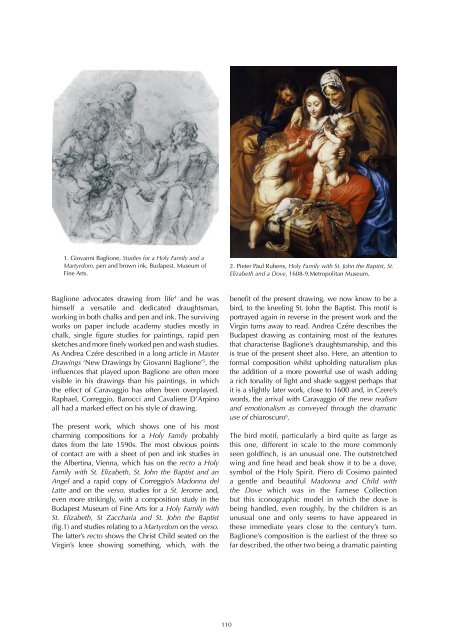Create successful ePaper yourself
Turn your PDF publications into a flip-book with our unique Google optimized e-Paper software.
1. Giovanni Baglione, Studies for a Holy Family and a<br />
Martyrdom, pen and brown ink, Budapest, Museum of<br />
Fine Arts.<br />
2. Pieter Paul Rubens, Holy Family with St. John the Baptist, St.<br />
Elizabeth and a Dove, 1608-9,Metropolitan Museum.<br />
Baglione advocates drawing from life 4 and he was<br />
himself a versatile and dedicated draughtsman,<br />
working in both chalks and pen and ink. The surviving<br />
works on paper include academy studies mostly in<br />
chalk, single figure studies for paintings, rapid pen<br />
sketches and more finely worked pen and wash studies.<br />
As Andrea Czére described in a long article in Master<br />
<strong>Drawings</strong> ‘New <strong>Drawings</strong> by Giovanni Baglione’ 5 , the<br />
influences that played upon Baglione are often more<br />
visible in his drawings than his paintings, in which<br />
the effect of Caravaggio has often been overplayed.<br />
Raphael, Correggio, Barocci and Cavaliere D’Arpino<br />
all had a marked effect on his style of drawing.<br />
The present work, which shows one of his most<br />
charming compositions for a Holy Family probably<br />
dates from the late 1590s. The most obvious points<br />
of contact are with a sheet of pen and ink studies in<br />
the Albertina, Vienna, which has on the recto a Holy<br />
Family with St. Elizabeth, St. John the Baptist and an<br />
Angel and a rapid copy of Correggio’s Madonna del<br />
Latte and on the verso, studies for a St. Jerome and,<br />
even more strikingly, with a composition study in the<br />
Budapest Museum of Fine Arts for a Holy Family with<br />
St. Elizabeth, St Zaccharia and St. John the Baptist<br />
(fig.1) and studies relating to a Martyrdom on the verso.<br />
The latter’s recto shows the Christ Child seated on the<br />
Virgin’s knee showing something, which, with the<br />
benefit of the present drawing, we now know to be a<br />
bird, to the kneeling St. John the Baptist. This motif is<br />
portrayed again in reverse in the present work and the<br />
Virgin turns away to read. Andrea Czére describes the<br />
Budapest drawing as containing most of the features<br />
that characterise Baglione’s draughtsmanship, and this<br />
is true of the present sheet also. Here, an attention to<br />
formal composition whilst upholding naturalism plus<br />
the addition of a more powerful use of wash adding<br />
a rich tonality of light and shade suggest perhaps that<br />
it is a slightly later work, close to 1600 and, in Czere’s<br />
words, the arrival with Caravaggio of the new realism<br />
and emotionalism as conveyed through the dramatic<br />
use of chiaroscuro 6 .<br />
The bird motif, particularly a bird quite as large as<br />
this one, different in scale to the more commonly<br />
seen goldfinch, is an unusual one. The outstretched<br />
wing and fine head and beak show it to be a dove,<br />
symbol of the Holy Spirit. Piero di Cosimo painted<br />
a gentle and beautiful Madonna and Child with<br />
the Dove which was in the Farnese Collection<br />
but this iconographic model in which the dove is<br />
being handled, even roughly, by the children is an<br />
unusual one and only seems to have appeared in<br />
these immediate years close to the century’s turn.<br />
Baglione’s composition is the earliest of the three so<br />
far described, the other two being a dramatic painting<br />
110
















